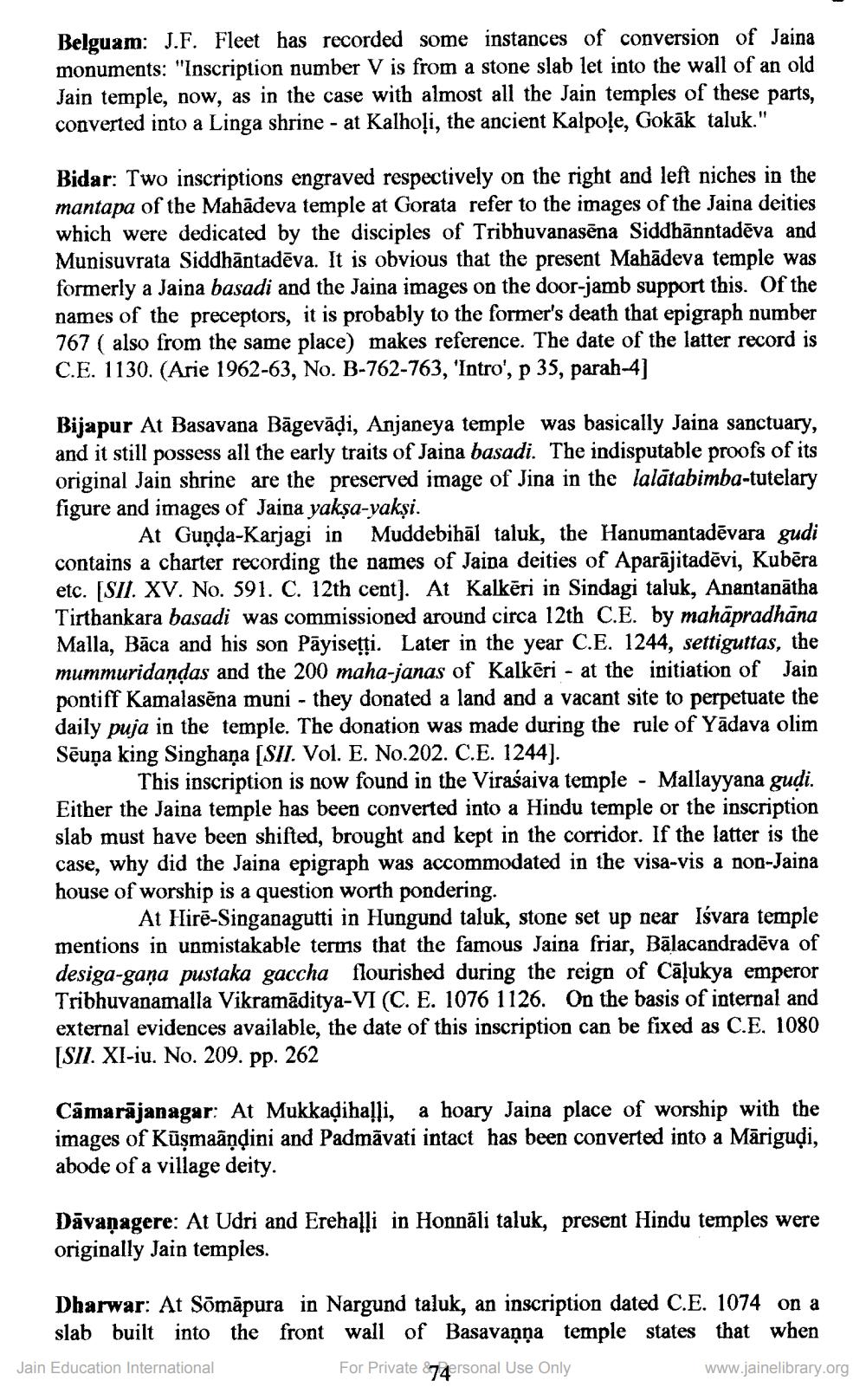________________
Belguam: J.F. Fleet has recorded some instances of conversion of Jaina monuments: "Inscription number V is from a stone slab let into the wall of an old Jain temple, now, as in the case with almost all the Jain temples of these parts, converted into a Linga shrine - at Kalhoļi, the ancient Kalpole, Gokāk taluk."
Bidar: Two inscriptions engraved respectively on the right and left niches in the mantapa of the Mahadeva temple at Gorata refer to the images of the Jaina deities which were dedicated by the disciples of Tribhuvanasēna Siddhānntadēva and Munisuvrata Siddhāntadēva. It is obvious that the present Mahadeva temple was formerly a Jaina basadi and the Jaina images on the door-jamb support this. Of the names of the preceptors, it is probably to the former's death that epigraph number 767 (also from the same place) makes reference. The date of the latter record is C.E. 1130. (Arie 1962-63, No. B-762-763, 'Intro', p 35, parah-4]
Bijapur At Basavana Bāgevāḍi, Anjaneya temple was basically Jaina sanctuary, and it still possess all the early traits of Jaina basadi. The indisputable proofs of its original Jain shrine are the preserved image of Jina in the lalatabimba-tutelary figure and images of Jaina yakṣa-yakṣi.
At Gunda-Karjagi in Muddebihal taluk, the Hanumantadēvara gudi contains a charter recording the names of Jaina deities of Aparajitadēvi, Kubēra etc. [SII. XV. No. 591. C. 12th cent]. At Kalkeri in Sindagi taluk, Anantanātha Tirthankara basadi was commissioned around circa 12th C.E. by mahāpradhāna Malla, Baca and his son Payiseṭṭi. Later in the year C.E. 1244, settiguttas, the mummuridandas and the 200 maha-janas of Kalkēri - at the initiation of Jain pontiff Kamalasēna muni - they donated a land and a vacant site to perpetuate the daily puja in the temple. The donation was made during the rule of Yadava olim Seuna king Singhaṇa [SII. Vol. E. No.202. C.E. 1244].
This inscription is now found in the Viraśaiva temple - Mallayyana guḍi. Either the Jaina temple has been converted into a Hindu temple or the inscription slab must have been shifted, brought and kept in the corridor. If the latter is the case, why did the Jaina epigraph was accommodated in the visa-vis a non-Jaina house of worship is a question worth pondering.
At Hire-Singanagutti in Hungund taluk, stone set up near Isvara temple mentions in unmistakable terms that the famous Jaina friar, Balacandradeva of desiga-gana pustaka gaccha flourished during the reign of Cāļukya emperor Tribhuvanamalla Vikramaditya-VI (C. E. 1076 1126. On the basis of internal and external evidences available, the date of this inscription can be fixed as C.E. 1080 [SII. XI-iu. No. 209. pp. 262
Câmarajanagar: At Mukkaḍihalli, a hoary Jaina place of worship with the images of Küşmaändini and Padmavati intact has been converted into a Māriguḍi, abode of a village deity.
Dāvanagere: At Udri and Erehalli in Honnali taluk, present Hindu temples were originally Jain temples.
Dharwar: At Sōmāpura in Nargund taluk, an inscription dated C.E. 1074 on a slab built into the front wall of Basavanna temple states that when For Private &ersonal Use Only
Jain Education International
www.jainelibrary.org




